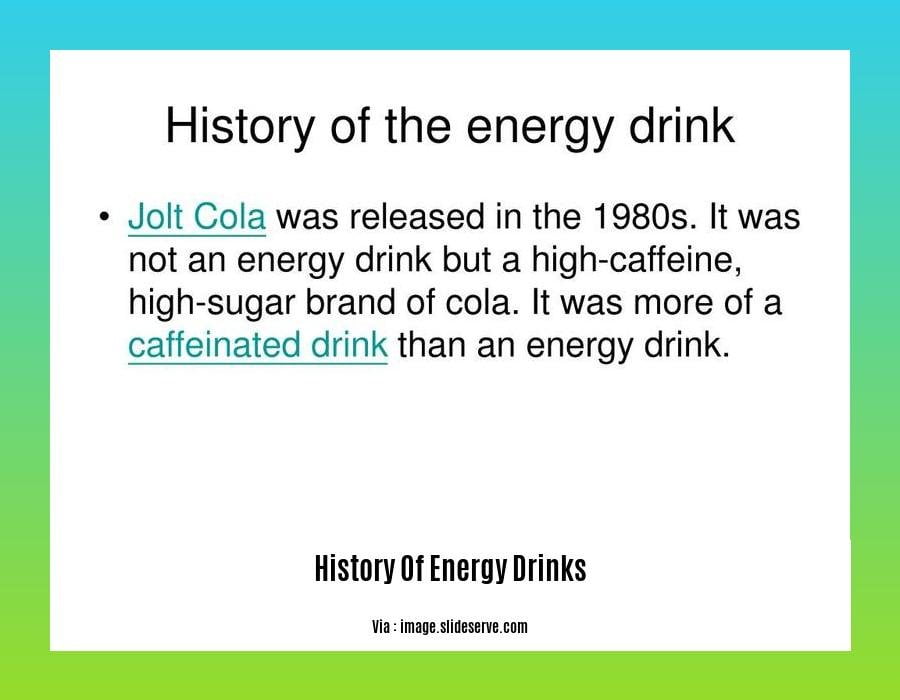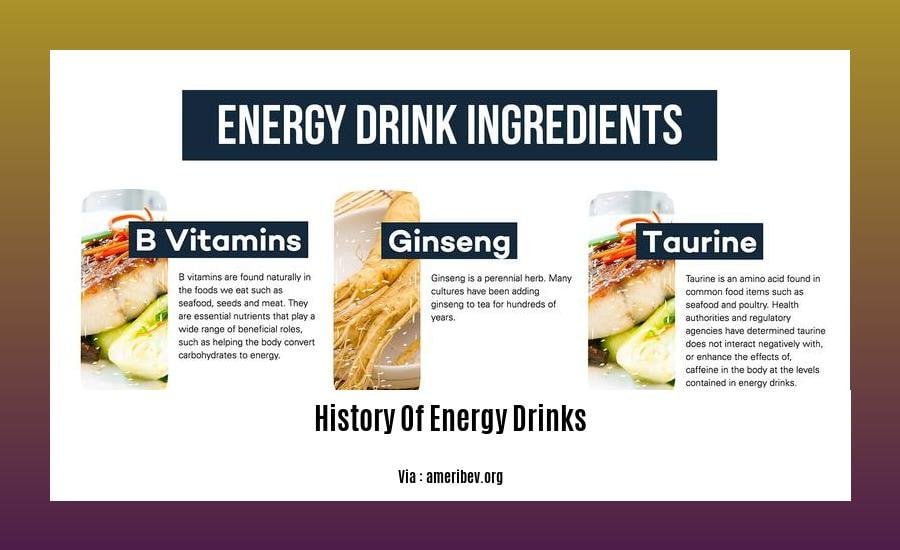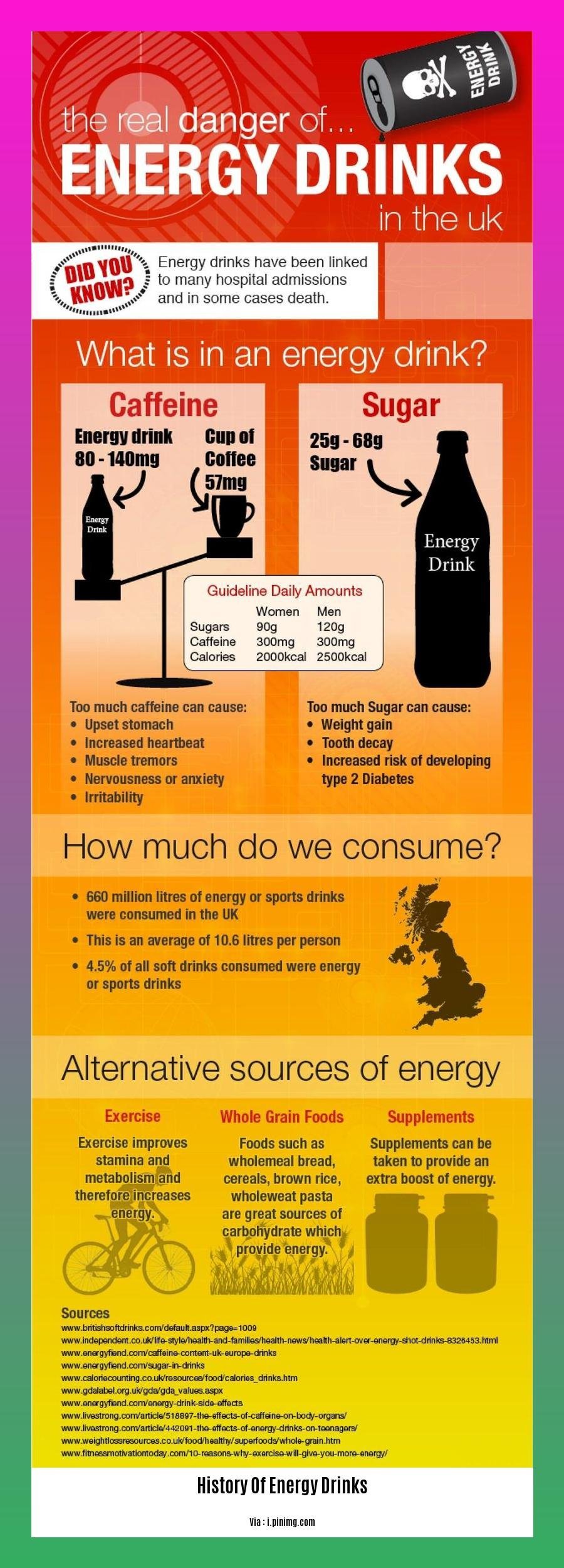Get ready for a shot of history as we dive into the electrifying world of energy drinks with “Raising the Energy: A Journey Through the History of Energy Drinks.” From their humble beginnings in 1984, when they first hit American shores, to their global takeover on April 1, 1987, we’ll explore the evolution of these potent concoctions that have become an integral part of our fast-paced lives. Join us on this caffeinated journey as we uncover the untold stories behind the brands, the marketing, and the cultural impact of energy drinks.
Key Takeaways:
Energy drinks have their roots in post-World War II Japan, with Lipovitan D being the pioneering product introduced in 1962.
Dietrich Mateschitz, an Austrian businessman, discovered these invigorating tonics during a trip to Bangkok and introduced the concept to the global market through the establishment of Red Bull.
The contemporary energy drink market is witnessing a growing demand for healthier options, prompting several brands to incorporate natural caffeine sources and overall healthier ingredients into their products.
Traditional energy drinks, characterized by high sugar and caffeine content, may pose certain health risks, potentially contributing to cardiovascular issues, anxiety, and disruptions in sleep patterns.
History of Energy Drinks

Have you ever wondered how a simple potion evolved into a multibillion-dollar industry, fueling the stamina of athletes, students, and partygoers alike? The journey of energy drinks is a thrilling roller coaster ride, filled with innovation, marketing prowess, and sometimes, controversies. In this blog series, we’ll delve into the captivating history of energy drinks, tracing their evolution from the post-war era to the present day.
Early Genesis: From Asia to the World
The roots of energy drinks can be traced back to the aftermath of World War II in Japan, where a new beverage called Lipovitan D emerged in 1962. This drink, containing taurine and B vitamins, was marketed as a revitalizing tonic for the weary population. Little did its creators know that they had just ignited a spark that would soon ignite a global fire.
The Red Bull Revolution
In 1982, the world was introduced to a new kind of energy drink that would change the game forever – Red Bull. Brainchild of Austrian entrepreneur Dietrich Mateschitz, Red Bull was a potent blend of caffeine, taurine, and B vitamins that promised to “give you wings.” Mateschitz’s aggressive marketing strategy, which included sponsoring extreme sports and music events, propelled Red Bull to the forefront of the energy drink market.
Conquering the Globe
Red Bull’s success inspired a wave of imitators, leading to a proliferation of energy drinks brands across the globe. Companies like Monster Energy, Rockstar, and 5-Hour Energy emerged, each trying to carve a niche for themselves in the increasingly competitive market. The energy drink industry had well and truly arrived, with sales soaring and consumers embracing these beverages for their energy boost and perceived performance enhancement.
The Health Factor
As the energy drink industry boomed, concerns about the potential health risks of these beverages began to surface. High levels of sugar and caffeine, coupled with other ingredients like taurine and B vitamins, raised questions about the long-term effects of excessive consumption. Some studies linked excessive energy drink intake to cardiovascular issues, anxiety, and disruptions to sleep patterns.
A Shift Towards Healthier Alternatives
In response to growing consumer demand for healthier options, the energy drink industry has begun to embrace change. Many brands are now exploring natural caffeine sources, such as green tea or guarana, and incorporating healthier ingredients like low-sugar or sugar-free alternatives. This shift towards healthier energy drinks reflects a growing trend among consumers who seek products that align with their wellness goals.
The Future of Energy Drinks
So, where does the future of energy drinks lie? The industry is likely to continue to evolve, driven by consumer demand for healthier, more functional products. We can expect to see further innovation in ingredients, packaging, and marketing, as brands strive to stay ahead of the curve. The journey of energy drinks has been a remarkable one, and it’s poised to continue for years to come, leaving us wondering what the next chapter holds.
If you’ve ever been captivated by the flaky crust of a croissant or the delicate sweetness of a crème brûlée, you won’t want to miss our comprehensive guide to the history of French pastries. Dive into the rich cultural heritage of French patisserie here as we delve into the origins and evolution of these delectable culinary creations.
History Of Energy Drinks In America

Key Takeaways:
- 1952: Japanese company Taisho introduced Lipovitan D, the world’s first modern energy drink, containing taurine, caffeine, and B vitamins.
- 1984: Red Bull’s founder, Dietrich Mateschitz, discovered energy drinks during a business trip to Thailand. Recognizing their potential, he founded Red Bull in Austria, initially marketed to blue-collar workers and truck drivers.
- 1997: Red Bull entered the US market, quickly gaining popularity among young professionals and college students. Its success spurred the growth of the energy drink industry in America.
- 1999: PepsiCo launched Josta, its first energy drink, but discontinued it in 2002 due to poor sales.
- 2002: Monster Energy Drink, a competitor of Red Bull, was introduced, known for its “beastly” branding and high caffeine content. It quickly gained market share in the US.
- 2004: The emergence of small-serving energy shots like 5-Hour Energy and Red Bull’s Red Bull Energy Shot provided a convenient and concentrated alternative to traditional energy drinks.
The History Of Energy Drinks In America has been marked by innovation, competition, and cultural shifts. From their origins in Japan to their global dominance, energy drinks have become an integral part of American culture, catering to consumers seeking a quick energy boost.
The Rise of Energy Drinks in America
The energy drink industry in America has experienced significant growth since the introduction of Red Bull in 1997. According to a report by Allied Market Research, the global energy drink market was valued at $55.8 billion in 2020 and is projected to reach $86.1 billion by 2030. This growth is attributed to several factors, including:
- Increasing consumer demand for convenient and portable energy sources
- The growing popularity of energy drinks among young adults and athletes
- The expansion of energy drink product lines to include sugar-free and low-calorie options
- The aggressive marketing and advertising campaigns by energy drink companies
The Health Implications of Energy Drinks
The popularity of energy drinks has raised concerns about their potential health implications. Energy drinks typically contain high levels of caffeine, sugar, and other ingredients that can have adverse effects on health, particularly when consumed in large quantities or over a long period. Some of the potential health risks associated with energy drinks include:
- Increased heart rate and blood pressure
- Anxiety and insomnia
- Dehydration
- Weight gain
- Dental problems
Regulation of Energy Drinks in America
The regulation of energy drinks in America is a complex issue. While the Food and Drug Administration (FDA) has not established specific regulations for energy drinks, it does regulate the safety of the ingredients used in these products. The FDA has also taken action against some energy drink companies for making false or misleading claims about their products’ health benefits.
In addition to the FDA, several states have enacted their own regulations on energy drinks. These regulations vary from state to state but typically focus on restricting the sale of energy drinks to minors or limiting the amount of caffeine that can be contained in an energy drink.
The Future of Energy Drinks in America
The future of energy drinks in America is uncertain. On the one hand, the demand for energy drinks is expected to continue to grow. On the other hand, there is increasing concern about the potential health risks associated with these products. It is likely that the FDA and state regulators will continue to play a role in shaping the future of the energy drink industry in America.
Sources
Go Big Energy
Energy Drink Information
1984: The Dawn of the Energy Drink Era
In 1984, the energy drink industry witnessed a pivotal moment with the introduction of Red Bull, boldly founded by Dietrich Mateschitz. While energy drinks had already made their mark in Asia with the 1962 debut of Lipovitan D in Japan, Mateschitz’s vision brought the energizing concoction to the forefront of the Western world.
Key Takeaways:
1984: Dietrich Mateschitz founds Red Bull in Austria, marking the genesis of the modern energy drink industry.
Global Phenomenon: Red Bull quickly gained international recognition, revolutionizing the beverage landscape and establishing a new category of pick-me-ups.
Marketing Mastermind: Mateschitz’s ingenious marketing strategies catapulted Red Bull to unprecedented heights, transforming it into a globally recognized brand and a symbol of energy and vitality.
Extreme Sports Alliance: Red Bull’s strategic association with extreme sports further cemented its reputation as an adrenaline-boosting beverage, resonating with a generation seeking a thrilling edge.
Unmatched Success: Red Bull’s trailblazing entry into the market set a precedent for the industry, leaving an indelible mark on the world of energy drinks.
[Source 1:
[Source 2:
FAQ
Q1: What is the origin of energy drinks?
A1: The history of energy drinks can be traced back to post-World War II Japan, where Lipovitan D, the first modern energy drink, was introduced in 1962.
Q2: Who brought energy drinks to the global stage?
A2: Austrian entrepreneur Dietrich Mateschitz played a crucial role in popularizing energy drinks globally. He founded Red Bull in 1984 and introduced it to the Western world, making energy drinks a global phenomenon.
Q3: How did energy drinks gain popularity in America?
A3: The introduction of Red Bull in the United States in 1997 marked a significant turning point for the energy drink industry in America. Red Bull’s marketing strategies and perceived ability to boost energy and alertness contributed to its widespread popularity.
Q4: What are some concerns associated with energy drinks?
A4: Concerns have been raised regarding the potential health risks associated with traditional energy drinks, primarily due to their high levels of caffeine, sugar, and other ingredients. Excessive consumption may lead to cardiovascular issues, anxiety, and disruptions in sleep patterns.
Q5: What are some trends in the energy drink industry?
A5: The energy drink industry has been witnessing a shift towards healthier alternatives in recent years. Several brands are exploring natural caffeine sources, healthier ingredients, and smaller serving sizes to cater to consumer demand for healthier options.










